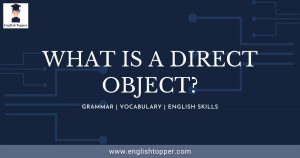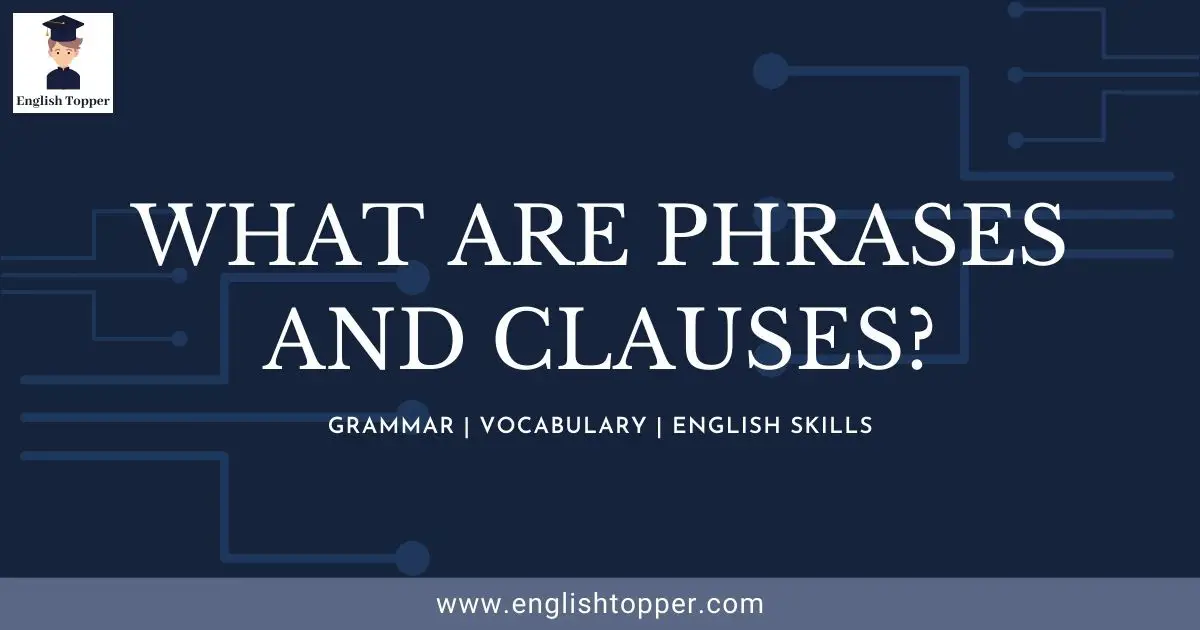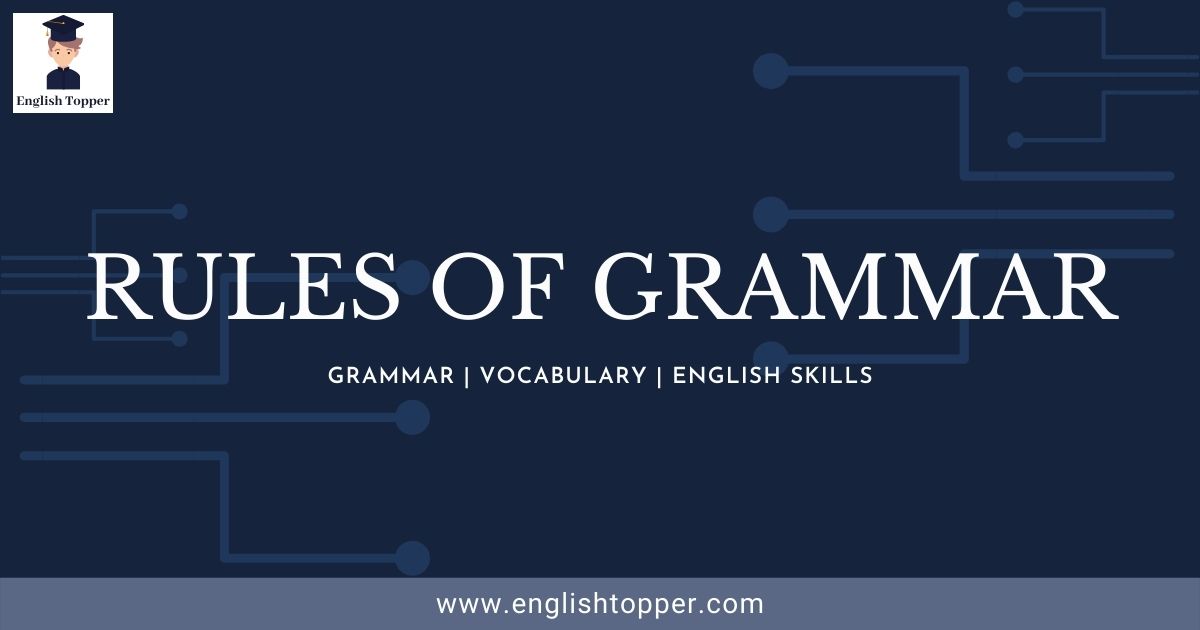|
Getting your Trinity Audio player ready...
|
Table of Contents
What is a Direct Object in a Sentence?
A noun, noun phrase or pronoun that is receiving the action in the sentence is known as a Direct Object. In other words, it also defined as the receiver of the action.
According to the English Grammar, the general format of the sentence is Subject – Verb – Object (SVO).
So, if we further classify the structure format in terms of Direct Object, then it will be,
Subject + Verb + Who (or) What
So, the object can either be
- a person (who is receiving the action from the subject) or
- a thing (that is receiving action from the subject)
Now let us understand this with few examples.
Note: Blue colour words are Direct Object words.
- Raju kicked the ball.
Here, “Raju” (Subject) performed an action “kicked” (Verb) on “the ball” (Direct Object).
- I ate an apple.
Here, “I” (Subject) performed an action “ate” (Verb) on “an apple” (Direct Object).
- Tina is watching TV.
Here, “Tina” (Subject) performing an action “is watching” (Verb) on “TV” (Direct Object).
- John loves football.
Here, “John” (Subject) showing an emotion “loves” (Verb) on “football” (Direct Object).
- She went to school.
Here, “Tina” (She) performing an action “went” (Verb) on ” to school” (Direct Object).
Below is the table which classifies components in a much simpler way.
| Subject | Verb | Direct Object |
| Raju | kicked | the ball. |
| I | ate | an apple. |
| Tina | is watching | TV. |
| John | loves | football. |
| She | went | to school. |
So, from the above table it is clear that the Direct Object is receiving or undergoing the action.
Note: Direct Object can be a word or group of words. So, it can also be,
- Noun
- Pronoun
- Noun Phrase
- Noun Clause
We will learn in detail in the coming topics. Now, let us understand the working of the verb with the Direct Object.
Use Transitive verbs for Direct Object
The only types of verbs which are used for Direct Objects are Transitive Verbs because this help transits the action from Subject to Direct Object by passing through it.
For those who don’t know what are Transitive Verbs? These are only used for the purpose of linking Direct Objects in the sentence. The verbs are used to assign the action to the receiver.
Whatever examples we read before, all those are Transitive Verbs.
Don’t use Linking verbs for Direct Object
Other verbs like Linking verbs are not used for the Direct Objects because these verbs don’t link to the receiver. It is the only verb used to link to the subject itself. So, there will be no Direct Objects.
Let us consider below examples.
- John is sleeping.
Here, we can observe that there is a Subject (John) and verb (is sleeping), but there is no Object to receive the action.
Because the verb which is used here is referring (describing) to the subject itself and not referring to some object.
- Antonie lived for 102 years.
Here, there is also no object and only the Subject is being described. So, the Subject is “Antonie” and the verb is “lived”.
- We arrived at the bus stand.
Here, We (Subject), arrived (Verb) and predicate is used (at the bus stand) are mentioned.
- She married on the year 2015.
Here also there is also no object and only the Subject is being described. So, the Subject is “She” and the verb is “married” and predicate (on the year 2015).
- I will go first.
Here, I (Subject), will go (Verb) and the predicate is used (first) are mentioned. As we discussed before that there is no Direct Object in this example sentence.
How to find the Direct Object in a Sentence?
Suppose you have got a sentence and you want to find a Direct Object in that, then how you can find it? It’s simple!
First, you need to recall the sentence format which we had discussed before.
i.e, Subject + Verb + Who (or) What
Then, identify and divide the sentence into smaller components (i.e, Subject, Verb, Direct Object and predicate which is optional).
If the Subject is assigning some action on someone or something, then it automatically becomes a Direct Object.
You can refer the examples which are mentioned in “What is a Direct Object in a Sentence?”.
Different function types of Direct Object
Here we are going to discuss about the different functions as a Noun, Pronoun, Phrase and Clause.
Noun as a Direct Object
Below is an example on how a Noun can be a Direct Object.
- They drink coffee.
Here, They (Subject), drink (Verb) and coffee (Direct Object) are mentioned. Since “coffee” is a name of a liquid/drink, so it is a Noun.
They drink what? “Coffee” is the direct object.
Pronoun as a Direct Object
Below is an example on how a Pronoun can be a Direct Object.
- Paul called her.
Here, Paul (Subject) called (verb) her (Direct Object). Since “her” is a Pronoun.
Paul called whom? “her” is the direct object.
Note: Always remember that the Subject Pronoun cannot become a Direct Object.
Noun Phrase as a Direct Object
Below is an example on how a Noun Phrase can be a Direct Object.
- Mary hates drinking ice tea.
Here, Mary (Subject) hates (verb) drinking ice tea (Direct Object). Since “drinking ice tea” is a phrase without having complete meaning.
Mary hates what? “drinking ice tea” is the direct object.
Noun Clause as a Direct Object
Below is an example on how a Noun Phrase can be a Direct Object.
- The thief admitted that he robbed money from the bank.
Here, The thief (Subject) admitted (Verb) that he robbed money (Direct Object) from the bank (Predicate) are the different components of the sentence.
The thief admitted what? “That he robbed money” is the direct object.
Also Read: What are Phrases and Clauses in English Grammar? (2021)
More examples of Direct Object
Direct Object can be used in any type of sentences like Positive, Negative and Question. Let us learn more about each type with few examples.
1) Direct Object in Positive Sentences:
- He bought a new car.
- Amanda loves her daughter very much.
- They play basketball a lot.
- She appreciated her maid today.
- John played with his old shoes.
- He (S) + bought (V) + a new car (DO).
- Amanda (S) + loves (V) + her daughter (DO) + very much.
- They (S) + play (V) + basketball (DO) + a lot.
- She (S) + appreciated (V) + her maid (DO) + today.
- John (S) + played (V) + with his old shoes (DO).
2) Direct Object in Negative Sentences:
- I don’t eat junk food.
- She can’t walk properly with heels.
- We don’t watch movies.
- They aren’t arriving via bus.
- Rahul doesn’t like to go to school.
- I (S) + don’t + eat (V) + junk food (DO).
- She (S) + can’t + walk (V) + properly with heels (DO).
- We (S) + don’t + watch (V) + movies (DO).
- They (S) + aren’t + arriving (V) + via bus (DO).
- Rahul (S) + doesn’t + like (V) + to go to school (DO).
3) Direct Object in Question type of sentences:
- Did the dog chase the car?
- Did the boy hit the ball?
- Did she marry him?
- Will he able to solve the math problems?
- Do they visit our house?
- Did + the dog (S) + chase (V) + the car? (DO)
- Did + the boy (S) + hit (V) + the ball? (DO)
- Did + she (S) + marry (V) + him? (DO)
- Will + he (S) + able to + solve (V) + the math problems? (DO)
- Do + they (S) + visit (V) + our house? (DO)
Quiz Time!
#1. “The teacher called a student”. Identify the Direct Object.
Answer: student
Explanation: Here “office” is a Direct Object because the word is receiving the action of the Subject.
Since we learned that SVO is a general sentence structure.
So, it can be classified as Sentence = Subject Verb Direct Object
Sentence = The teacher (S) called (V) a student (DO)
#2. “John drove a new car”. Identify the correct Direct Object.
Answer: new car
Explanation: Here “new car” is a Direct Object because the word is receiving the action of the Subject.
Since we learned that SVO is a general sentence structure.
So, it can be classified as Sentence = Subject Verb Direct Object
Sentence = John (S) drove (V) a new car (DO)
#3. Linking Verbs are also used for the Direct Object. Is it true or false?
Answer: False
Explanation: Linking Verbs cannot be used for Objects, so there is no usage for Direct Object.
#4. “Mary is walking”. Identify the type of Verb used in the sentence.
Answer: Linking Verb.
Explanation: The given sentence has a Linking verb and has no Direct Object.
Since the Linking verb doesn’t have a Direct Object.
i.e, Sentence = Subject Verb Direct Object
Sentence = Mary (S) is walking (V)
#5. Direct Object can also function as?
Answer: All of the mentioned.
Explanation: A noun, noun phrase or pronoun that is receiving the action in the sentence can be a Direct Object.
#6. “Rahul is playing football”. Identify the Direct Object in the given sentence.
Answer: Rahul
Explanation: Rahul is the Direct Object because the word is receiving the action of the Subject.
Since we learned that SVO is a general sentence structure.
So, it can be classified as Sentence = Subject Verb Direct Object
Sentence = Rahul (S) is playing (V) football (DO)
#7. “He went to the office”. Identify the Direct Office.
Answer: office
Explanation: Here “office” is a Direct Object because the word is receiving the action of the Subject.
Since we learned that SVO is a general sentence structure.
So, it can be classified as Sentence = Subject Verb Direct Object
Sentence = He (S) went (V) to the football (DO)
#8. “They like Lemon Juice”. Identify the Direct Object.
Answer: Lemon Juice.
Explanation: Lemon Juice is the Direct Object because the word is receiving the action of the Subject.
Since we learned that SVO is a general sentence structure.
So, it can be classified as Sentence = Subject Verb Direct Object
Sentence = They (S) like (V) Lemon Juice (DO)
#9. Transitive Verbs are used for Direct Object. Is it true or false?
Answer: True
Explanation: Transitive Verbs are the only verbs that are used for Direct Object.
#10. The object can be _________.
Answer: either a person or a thing.
Results
Hurray….. You have passed this test! 🙂
Congratulations on completing the quiz. We are happy that you have understood this topic very well.
If you want to try again, you can start this quiz by refreshing the page.
Otherwise, you can visit the next topic 🙂
Oh, sorry about that. You didn’t pass this test! 🙁
Please read the topic carefully and try again.
Summary: (What is a Direct Object in a Sentence?)

- The definition of Direct Object is a word or group of words that receives the action from the Subject in the sentence.
- It can be either a person or a thing and it can function in multiple ways such as Noun, Pronoun, Phrase and Clause.
- The format will be in Subject + Verb + Who (or) What.
- Transitive Verbs are the only verbs used for the Direct Objects.
- Verbs like Linking verbs are not used for the Direct Objects.
If you are interested to learn more, then you can refer to Wikipedia here.
I hope that you understood the topic “What is a Direct Object in a Sentence?”. If you still have any doubts, then comment down below and we will respond as soon as possible. Thank You.







